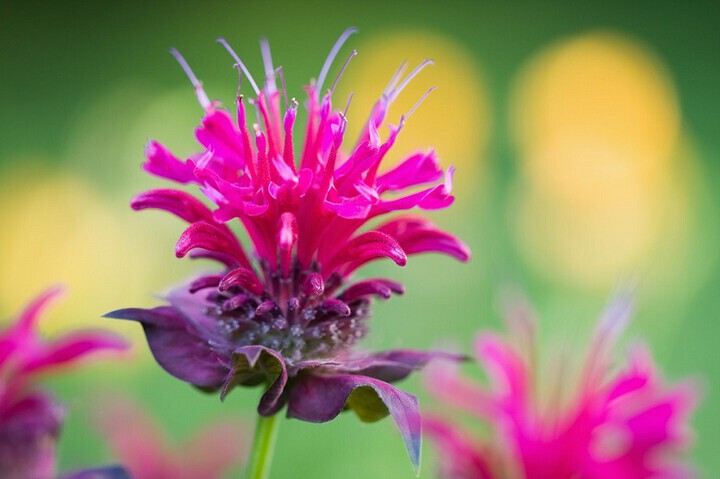This pretty flower does more than just add color to your garden.

When it comes to planning your garden, bee balm is a perennial that offers both aesthetic appeal and function: Known scientifically as monarda, bee balm blooms with tube-shaped petals in shades of pink, red, violet, and purple, and certain varieties can even be used to make tea. The plant also turns your yard into a haven for critically important pollinators. "Bee balm is a great native perennial in the northeast U.S.," says Marshall Green, nursery manager and co-owner of Primex Garden Center. "Bee balm is a fantastic nectar source for bees, butterflies, and hummingbirds and makes a beautiful display in a perennial border or sunny area in any garden."
Where to Plant Bee Balm
Bee balm thrives in a spot with "sun, sun, and more sun!" says Green; look for an area that receives six hours or more of full sunlight every day. Most types grow best in well-drained soil, though you'll find that some types of bee balm have more flexible growing requirements. "Rich soils with sufficient organic matter will produce healthier plants, but some species, such as M. punctata, can tolerate sandy soils," says native plant expert Mikaela Boley, horticulture educator for University of Maryland Extension Office in Talbot County. "M. didyma, or scarlet bee balm, prefers moist, loamy soils." Native species can grow as high as four feet and, as a relative of the mint family, will spread quickly, making them best-suited to in-ground planting. Even so, Boley says that smaller cultivars can grow in a container without overwhelming their dedicated space.
How to Care for Bee Balm
Bee balm is generally considered to be a low-maintenance plant. "If monarda is happy it requires very little care," says Green. "Deadheading will improve the overall look of the plant and may prolong its bloom time but will not promote another bloom cycle." The plant is susceptible to a disease called powdery mildew, which is easily treated by planting in full sun to ensure the leaves dry properly, thinning the plants to improve air circulation, or cutting it back and letting it regenerate. "While somewhat unsightly, powdery mildew rarely is detrimental to the plant and does not affect its' herbal properties," says Boley. To prepare the plant for winter, Green recommends cutting it back to the ground after a hard frost—usually in late October or November—and lightly mulching it. Another option, says Boley, is to allow the stems—either at full height, or cut back to 12 to 18 inches—to remain until the end of the winter. "This provides shelter, food, and overwintering habitat for birds, mammals, and insects. Many of our beneficial insects overwinter in plant material, and by cutting back and removing that material, you take away those resources."
What to Plant with Bee Balm
The distinctive tube-shaped flowers, vibrant colors, and dramatic height make bee balm a pretty complement to other common backyard plants. "In my opinion it looks great with taller summer flowering perennials like black eyed Susan, echinacea, or garden phlox," says Green. Boley suggests planting bee balm with "other prairie or meadow-like species," including butterfly milkweed and rough goldenrod. "The key strategy is to plant a variety of plants that will bloom at different times throughout the year; this provides a greater variety of nectar and pollen source for our pollinators," she says. Since bee balm spreads so efficiently, it might also ward off invasive plants or weeds. "For those with plenty of sunny space, bee balm will fill in nicely and create a very natural-looking landscape," says Boley.